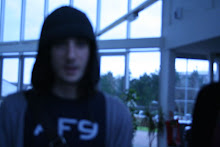This week i ventured down to Lands End. I went to lands end in hope that there would be a landscape with enough variety in a small area to make the idea of Hockney's composite images work. As i see the last image as 12 images i dont count the other two as having anything to do with the Hockney idea, but i liked them so added them in for good measure. Ideally i would've shot all of these photo's on polaroid, even having polaroid film right now, it is not the right type to shoot non experimental images with. Therefore i added a slightly vignetted, washed out texture to all of these images to give them as slightly more interesting feel. I found i wanted to also do this as i am slowly moving away from liking digital photography of landscapes. The word generic springs to mind.
David Hockney challenged the idea that we see from just one perspective when there is so many different views on things that we cannot possibly see with our eyes. By doing these joiners he tries to show a wider view or a view me may not usually see of an object with our eyes. This technique is also influenced and originates from people such as Picasso.
This building was behind the one below except this was open and appeared to be completely derelict. The reason i initially photographed this was because of the amazing view out of the window but i also once inside, loved the textures of the walls. I like the whole rawness of it, with the rusted wired reel on the floor completing that feel off. I really like derelict buildings, and this could be an idea for the future. Composition wise this isn't perfect but i like the way the wall leads you to the first window and then continues on to the rest of the room.
With this image i had real debate as to whether i liked the washed out effect, i do, but i'm still pretty sure that i like original which is also not cropped. I wanted to stick to the theme so went ahead with cropping and washing it out but i will probably post the other somewhere else on my blog. What i like about this image is the rich sunlight hitting the top of this small building, casting a wavy shadow across the cliff side. I also like the way the building is not perfectly straight which reminds you of the weathering process that the coastal area's go through.
This way Hockney shoot's his composite images, to give the viewer a wider knowledge and view of the area that is being photographed. This has plagued me for the past couple of week's, literally once starting to shoot finding it overwhelming and too hard to not over think it and end up not knowing what to shoot. In the end i found this place at land's end, which had a nice variety of textures and things to photograph in one area. The top row consist of the sea and a large hill far off to the left, and a large rock to the far right in the far distance. the second row consists of a hill side, a lower down small waterfall and where the land begins after the sea. The third row consists of all literally the rocks leading up to the highest point i could find, these are spread out around the whole area spanning i'd say about one hundred metres, i put these similar shots in to show that the angles change more than the terrain. The last row, is of what was around my feet. I shot my feet to give the illusion that i could see all of this from where i was standing, and the frame to the left i intentionally got my feet in part of it to make it seem even more like i was just moving the camera. Overall i am very happy with this, i really like the washed out effect of it all. I'm not sure how to talk about the composition of this so i think i'll just say that the way the pictures are laid out with the vignetting around the edges almost makes it seem like polaroids organised then scanned in, rather than digital images arranged on photoshop. My favourite frame of the whole image is definitely the top right i may even make that a single image at some point.
I will definitely re visit this technique and build on it.



